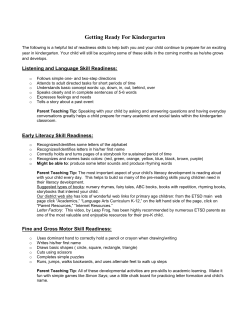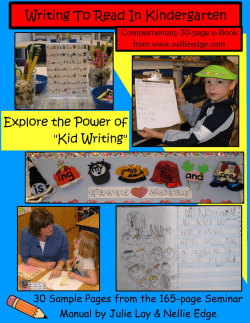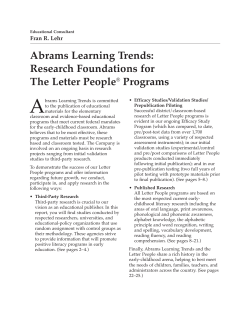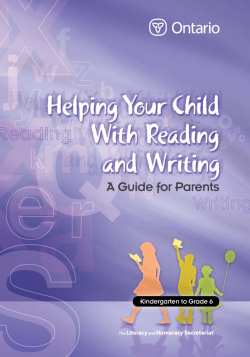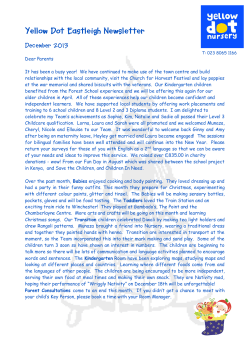
1 Chapter Literacy Learning in Preschool and Kindergarten
Chapter 1 Literacy Learning in Preschool and Kindergarten Preschool and kindergarten are the most important grades! I say this to preschool, kindergarten, primary, middle school, junior high, and high school teachers. I passionately share this with administrators, parents/ caregivers, and politicians. I want to yell it from the rooftops! The research is clear. School systems working with families have a small window of opportunity in which to get children off to a strong start. Research indicates that children who begin third grade struggling in reading and writing rarely catch up with their age-appropriate peers and tend to struggle all the way through high school (Snow 1998). All children deserve a strong start. Early childhood is crucial to later success in school and in life. Literacy Learning in Preschool and Kindergarten Can Change Lives Emerging literacy results at the end of kindergarten are very predictive of reading and writing achievement levels at the end of Grade 1. This finding is extremely important because research indicates that there is close to a 90 percent probability that children struggling with reading (and often writing) at the end of Grade 1 will remain poor readers (and often writers) by the end of Grade 4 (Allington, 1998, 12). Kindergarten teachers can predict at the end of the kindergarten year where most of the children will be in literacy learning by the end of Grade 1. The good news is that teachers, beginning in preschool, can prevent this negative spiral from occurring for at least 95 percent of young learners. What preschool and kindergarten teachers (and other primary teachers) do or do not do really makes a difference. All I really need to know I learned in kindergarten. (Robert Fulghum, 1988) Although first-grade interventions are necessary for some children, the best intervention is well-designed kindergarten instruction (CIERA 1998a). Research indicates that preschool education is a sound investment academically, socially, and economically. (Barnett and Hustedt, 2003). Figure 1.1 Literacy Learning in Preschool and Kindergarten 11 In fact, research indicates that what happens in preschool and kindergarten is long lasting and powerful. Kindergarten literacy learning even affects classroom achievement in middle and high school. Longitudinal research by Ralph Hanson and Diane Farrell (1995) tracked close to 4,000 students from kindergarten to Grade 12. Approximately one-third of the students had been taught to read in kindergarten. The other two-thirds had not learned to read in kindergarten. Reading had not been a kindergarten focus area in their classrooms. “The major finding of this study is that students who learned to read in kindergarten were found to be superior in reading skills and all other educational indicators as measured as seniors in high school. This finding held up across districts and schools, as well as ethnic, gender and social class groups. Also, there was absolutely no evidence of any negative effects from learning to read in kindergarten” (p. 929). These students not only displayed higher grades but also had better attendance in school. The study concludes, “Any school district with a policy that does not support kindergarten reading should be ready to present new and compelling reasons to explain why not . . . !” (929). Receptive vocabulary refers to words that are understood by a reader or a listener. Expressive vocabulary refers to the words that one uses to communicate as a speaker or a writer. The IRA and NAEYC Joint Position Statement states that “Failing to give children literacy experiences until they are school age can severely limit the reading and writing levels they ultimately attain” (1998, 6). Oral Language is the foundation of literacy learning. 12 Other research also confirms that children’s language and literacy skills in preschool and in kindergarten are strongly related to later academic success. “The receptive vocabulary scores of kindergarten students near the end of kindergarten were strongly related to the end of seventh grade vocabulary and reading comprehension” (Dickinson and Sprague 2001, 273). Additionally, the quality of writing support given to 4-year-olds is highly related to their literacy growth at the end of kindergarten and Grade 1. And of course the children’s vocabulary levels and background knowledge have a significant impact on their writing. Develop Strong Readers and Writers The landmark work of Catherine Snow, Susan Burns, and Peg Griffin (1998) indicates that young children develop into strong readers and writers when their teachers focus on these foundational areas of literacy development: • Alphabet letter knowledge/letter recognition • Phonological (including phonemic) awareness • Letter–sound correspondence (phonics) • Concepts about print and books • Oral comprehension and vocabulary (listening and speaking, receptive and expressive language) LEARNING TO WRITE AND LOVING IT! Figure 1.2 This is an important message! Predictors of Literacy Success As stated earlier, kindergarten teachers can predict at the end of the kindergarten year where most of the children will be in literacy learning by the end of Grade 1. According to Marilyn Jager Adams, prereaders’ ability to recognize and name letters (letter knowledge) is “the single best predictor of firstyear [Grade 1] reading achievement, with their ability to discriminate phonemes auditorily ranking a close second. Furthermore, these two factors were the winners regardless of the instructional approach used” (1990, 36). However, “it is not simply the accuracy with which children can name letters that gives them an advantage in learning to read [and write], it is the ease or fluency [speed] with which they can do so. . . . A child who can recognize most letters with thorough confidence will have an easier time learning about letter sounds and word spellings than a child who still has to work at remembering what is what” (p. 43). PREDICTORS OF EARLY LITERACY SUCCESS 1.Letters 2.Phonological/ Phonemic Awareness 3.Oral Language According to research, knowing letter names is important because they contain a sound typically represented by the letter. For example, recognizing a d helps the reader to remember that its sound is /d/. The more time children have to spend on figuring out letters, the less time and energy they will have available to use other strategies to decode print and to write. Thus, letter recognition must become automatic. Literacy Learning in Preschool and Kindergarten 13 Phonological awareness involves the understanding or awareness of the structure of oral language: that oral language is made up of words, and words consist of syllables, rhymes, and individual sounds or phonemes. Help prevent the fourth-grade literacy slump by enhancing oral language development in preschool and kindergarten. The second best predictor of reading success is the child’s ability to discriminate between phonemes (individual letter sounds). Phonemic awareness is one aspect of phonological awareness. It involves • an understanding that oral language is composed of a series of individual sounds, and • the ability to play with these sounds. “Enhancing children’s letter knowledge and phonological awareness skills should be a priority goal in the kindergarten classroom” (Snow 1998, 188). However, no matter how skilled the child is in alphabet letter knowledge and phonological awareness, he or she still needs a strong understanding of both the concepts about books and about print, and a strong foundation in oral language. Oral language proficiency (receptive and expressive), which includes vocabulary knowledge, is a third strong predictor of future literacy success that lasts well into high school. Figure 1.3 Turn and talk develops both oral language and comprehension. Literacy Experiences and the Emergent/Early Reader and Writer Much of the landmark research on emergent literacy development comes from the work of Dolores Durkin in the 1960s. Durkin studied the home environments of many children who had learned to read before entering kindergarten. She found that these children received on average 1,000 to 1,500 hours of preschool literacy experiences. These home experiences included • frequent read-alouds and discussion • the teaching of alphabet letters and their sounds • the teaching of “sight words” or high-frequency words • providing help to the child based on the child’s questions and requests for assistance 14 LEARNING TO WRITE AND LOVING IT! • making rhymes with words • reading-related activities (for example, playing with magnetic letters on the fridge to create some words or “writing” a letter to someone) • providing many opportunities to write • listening to the child “read” • engaging in literacy activities “on the run” (for example, reading signs and food labels) Early childhood teachers need to provide intentional literacy experiences similar to what the children in Durkin’s research were exposed to at home. For example, they need to • read to the children and discuss what was read • provide many shared reading experiences • engage the children in many intentional activities to support oral language development • teach alphabet letter names and sounds • point out “sight words” (high-frequency words) • develop phonological awareness (an ability to play with language) • provide many opportunities to model writing and frequently engage children in motivating writing experiences using both invented (temporary) spelling and for-sure words, such as their names (see page 38 for more information on for-sure words) • listen to each child “read” (books, environmental print, and even their own writing) and provide instruction and modeling • support their play When preschool and kindergarten teachers provide the intentional literacy activities listed above, most children will exhibit the seven signs of emergent literacy cited by Patricia Cunningham and Richard Allington in their well-loved book Classrooms that Work: They Can All Read and Write (New York: HarperCollins, 1994). Seven Signs of Emergent Literacy The child 1.can “pretend read” favorite books and poems/songs/chants 2.can “drite” and can read what he or she has written even if no one else can 3.can “track print” (that is, show you what to read and point to the words using left–right/top–bottom conventions) drite = draw and write 4.knows critical jargon (for example, she or he can point to a specific word, the first word in a sentence, one letter in a word, the first letter in a word, the longest word in a sentence, and so on) Literacy Learning in Preschool and Kindergarten 15 5.recognizes some concrete words (for example, his or her name, the names of other children, favorite words from books, poems, and chants, and so on) 6.recognizes if words rhyme and can make up rhymes 7.can name many letters and can tell you words that begin with the common initial sounds (Cunningham and Allington 1994, 143) “Although it may seem as though some children acquire these understandings magically, or on their own, studies suggest that they are the beneficiaries of considerable, though playful and informal, adult guidance and instruction” (IRA and NAEYC 1998, 32). As much as it is true that young children play and discover many things on their own, it also is true that they need adult assistance and guidance (Schickedanz 1994, 46). Unfortunately, not all children receive the preschool support described by Dr. Durkin. At Risk in Preschool and Kindergarten Large numbers of children arrive in preschool or kindergarten behind before they even start. “More than one in four children in Ontario Canada who enter Grade 1 are significantly behind their peers” (Dr. Charles Pascal 2009, 4). Ontario is not alone. The research indicates that children who are most likely to have difficulty with literacy learning are those who begin school with less prior knowledge and skill in areas such as oral language and background knowledge, phonological awareness, alphabet letter knowledge, print awareness, and writing. What is most important for all children is that schools provide strong kindergarten literacy programs and effective intervention in kindergarten. The gift of time (waiting) is generally no gift at all. To determine if a child is at risk, teachers need to know what specific literacy skills and understandings they should expect of students by the end of kindergarten. Literacy Skills and Understandings in Kindergarten Research consistently points to the importance of ensuring that children enter Grade 1 with the attitude toward and knowledge about literacy that will enable them to succeed (Snow, Burns, and Griffin 1998). 16 LEARNING TO WRITE AND LOVING IT! Figure 1.4 Giving children many opportunities to sit together to look at and discuss books is very important. Children develop literacy from birth and excel as they • develop both a rich vocabulary and a deep understanding of many concepts and language structures. Developing reasoning, creative and critical thinking, and inquiry skills is crucial. • learn that written language is a system for representing oral language. • learn concepts about print (what is a letter, what is a word, directionality) and concepts about books (the purpose of a book, book features). • learn that speech can be segmented into small units of sound and learn how to play with language (phonological awareness) by rhyming, segmenting, and blending for example. • learn to recognize alphabet letters and their corresponding sounds. • learn how to print most letters (when provided with letter names, sounds, pictures, or key words) and a few words (using invented spelling and a few for-sure words, such as their names and other familiar and high-frequency words). • see a purpose for writing and want to write. • recognize their own names in print in addition to a few other familiar and high-frequency words. • see a purpose for reading and want to read. • enjoy being read to. • are able to listen to and understand stories and informational books. Their retellings must include important information or ideas. • choose to look at books independently. • begin to see themselves as readers and writers. Develop Vocabulary, Concepts, and Reasoning Understand Concept of Written Language Understand Concepts About Print and About Books Develop Phonological Awareness Learn Letter Names and Sounds Print Letters and Words See a Purpose for Writing and Want to Write Recognize Words See a Purpose for Reading and Want to Read Enjoy Being Read To Listen With Understanding Choose to Look at Books See Oneself as a Reader and a Writer Literacy Learning in Preschool and Kindergarten 17 Continuum of Children’s Development in Early Reading and Writing Tables 1.1 through 1.3 list the end-of-year literacy skills and understandings for preschool, kindergarten, and Grade 1 children. This list is intended to be illustrative, not exhaustive. Children at any grade level will function at a variety of phases along the reading–writing continuum. Since it is important for kindergarten teachers to be aware of developmentally appropriate expectations before and after preschool and Grade 1, goals for those levels have also been included. Table 1.1 Continuum of Literacy Skills: Phase 1 PHASE 1: Awareness and exploration (goals for preschool) Children explore their environment and build the foundations for learning to read and write. Preschoolers . . . •enjoy listening to and discussing storybooks •understand that print carries a message •engage in reading and writing attempts •identify labels and signs in their environment •share books with children (including Big Books) and model reading behaviors •talk about letters by name and sounds •establish a literacyrich environment •reread favorite stories •participate in rhyming games •engage children in language games •identify some letters and make some letter–sound matches •promote literacyrelated play activities •use known letters or approximations of letters to represent written language (especially meaningful words like their name and phrases such as I love you) 18 So preschool teachers . . . LEARNING TO WRITE AND LOVING IT! •encourage children to experiment with writing And family members should be encouraged to . . . •engage their child in conversation, provide the names for things, and show interest in what their child says •read and reread stories with predictable texts •encourage their child to recount experiences and describe ideas and events that are important •visit the library regularly •provide opportunities to draw and print using markers, crayons, and pencils PHASE 2: Experimental reading and writing (goals for kindergarten) Children develop basic concepts of print and begin to engage in and experiment with reading and writing. Kindergarteners . . . So kindergarten teachers . . . And family members should be encouraged to . . . •enjoy being read to and can retell simple narrative stories and nonfiction text •encourage children to talk about reading and writing experiences •read and/or reread narrative stories and nonfiction texts to their child daily •use descriptive language to explain and explore •provide many opportunities for children to explore and identify sound– symbol relationships in meaningful contexts •encourage their child’s attempts at reading and writing •recognize letters and letter–sound matches •show familiarity with rhyming and beginning sounds •understand left-toright and top-tobottom orientation and familiar concepts of print •match spoken words with written words •begin to write letters of the alphabet and some high-frequency words •begin to see themselves as writers and illustrators •help children to segment spoken words into individual sounds and blend the sounds into whole words (for example, by slowly writing a word and saying its sound) •frequently read aloud interesting and conceptually rich stories •allow their child to participate in activities that involve reading and writing (for example, cooking, making grocery lists) •play games with their child that involve specific directions (such as Simon Says) •have conversations with their child during mealtimes and throughout the day •provide daily opportunities for children to write •help children to build a sight vocabulary •create a literacy-rich environment for children to engage independently in reading and writing (Continued) Literacy Learning in Preschool and Kindergarten 19 Table 1.1 (Continued) PHASE 3: Early reading and writing (goals for Grade 1) Children begin to read simple stories and can write about a topic that is meaningful to them. Grade 1 children . . . So Grade 1 teachers . . . •read and retell familiar stories •support the development of vocabulary by reading daily to the children, transcribing their language, and selecting materials that expand children’s knowledge and language development •use strategies (rereading, predicting, questioning, contextualizing) when comprehension breaks down •use reading and writing for various purposes on their own initiative •orally read with reasonable fluency •use letter–sound correspondence, word parts, and context to identify new words •identify an increasing number of words by sight •sound out and represent all substantial sounds in spelling a word •write about topics that are personally meaningful •attempt to use some punctuation and capitalization •see themselves as writers and illustrators •model strategies and provide practice for identifying unknown words •give children opportunities for independent reading and writing practice And family members should be encouraged to . . . •talk about favorite storybooks •read to their child and encourage the child to read to them •suggest that their child write to friends and relatives •bring to a parent– teacher conference evidence of what their child can do in writing and reading •encourage their child to share what he or she has learned about writing and reading •read, write, and discuss a range of different text types (poems, informational books) •introduce new words and teach strategies for learning to spell new words •demonstrate and model strategies to use when comprehension breaks down •help children build lists of commonly used words from their writing Source: Adapted from “Learning to Read and Write: Developmentally Appropriate Practices for Young Children.” The Reading Teacher 52 (1998): 193–216. Copyright 1998 International Reading Association. This is a joint position statement of the International Reading Association and the National Association for the Education of Young Children. 20 LEARNING TO WRITE AND LOVING IT! Figure 1.5 Making Your Program Developmentally Appropriate The International Reading Association and the National Association for the Education ofYoung Children (1998, 38) defines developmentally appropriate as the goals and expectations for young children’s achievement, which are challenging but achievable, with sufficient adult support. Developmentally appropriate not only refers to what teachers should expect children to be able to learn but also how best to support this learning. (For examples of developmentally appropriate literacy expectations for preschool and kindergarten children, see pages 18–20.) “Excellent teachers know it’s both what you teach and how you teach” (Copple and Bredekamp 2009, 48). Early childhood teachers set developmentally appropriate goals and expectations based on • their understanding of child development, • their understanding of literacy learning, including current research in the areas of assessment and instruction, and • their knowledge of the children’s strengths, interests, and needs. An activity is developmentally appropriate if • the child is able to do the task, and • the task is worthwhile (effective) in moving the child toward a particular goal (supports a goal). According to Sue Bredekamp (1997), former director of professional development for NAEYC, “Too many preschool and kindergarten teachers, perceiving themselves as advocates of developmentally appropriate practice, fear pushing children too much academically and fail to teach them the knowledge and skills they need” (p. 38). It is clear that children need focused teaching, but they also need spontaneous and planned play experiences during language arts and across the day. Literacy Learning in Preschool and Kindergarten 21 Literacy Learning and Play Check It Out! “Chopsticks and Counting Chips: Do Play and Foundational Skills Need to Compete for the Teacher’s Attention in an Early Childhood Classroom?” by Elena Bodrova and Deborah J. Leong in Beyond the Journal: Young Children on the Web (Washington, DC: National Association for the Education of Young Children, 2004), 1–7. Also see Spotlight on Young Children and Play, edited by Derry Koralek (Washington, DC: National Association for the Education of Young Children, 2004). “The Importance of Being Playful,” by Elena Bodrova and Deborah J. Leong in Educational Leadership 60, no. 7 (2003): 50–53. Young children are meant to play and literacy learning naturally supports play. “Children benefit both from engaging in self-initiated spontaneous play and from teacher-planned and structured activities, projects and experiences” (Copple and Bredekamp 2009b, 49). “Rather than detracting from academic learning, play appears to support the abilities that underlie such learning and thus to promote school success” (Copple and Bredekamp 2009b, 15). There are many reasons why children should play at home and at school. Play develops: • Social skills and self-regulation • Abilities to problem solve • Oral language • Creativity • Knowledge and skills Teacher scaffolding of mature (imaginative, creative) play supports specific literacy skill development such as oral language and phonological awareness. It also supports student self-regulation and successful school adjustment (Bodrova and Leong, 2004). See Chapter 8, page 205, “Play Plans Before and After Centers.” Judith Schickedanz says it best: “We will not have done our best for young children if we deny them the path to learning they seek through play. But, we also will not have done our best if we fail to provide instruction. As much as it is true that young children play and discover many things on their own, it is also true that children need adult assistance or guidance. It is possible to preserve childhood and to give children access to academic skills” (1994, 46). Play-based learning and focused teaching are NOT mutually exclusive. Young children need both! Check It Out! Playing is Learning is a great pamphlet for parents of preschool and kindergarten children (http://www.etfo.ca/ELKP/ PlayingisLearning/Documents/ PlayingisLearning.pdf). 22 LEARNING TO WRITE AND LOVING IT! Figure 1.6 Warming our hands over the campfire at the camping center. Many examples of effective play-based literacy activities are embedded throughout this book. Also see Chapter 8, “Play Plans Before and After Centers.” Look for this icon that indicates opportunities to scaffold learning through play-based literacy activities. Literacy Learning Across the Day Literacy learning occurs across the day. Writing occurs during writing workshop (see Chapter 5) and during play at centers. It also occurs across the day, across the curriculum. Integration is a natural approach for early childhood teachers. Through cross-curricular integration in areas such as social studies and science, young children are able to develop literacy skills while acquiring important “big ideas” involving hands-on activities. Children learn best when the concepts, vocabulary, and skills they encounter are related to things they know and care about and when the new learnings are interconnected (Copple and Bredekamp 2009b). Because children learn best when they see a specific purpose for what they are learning, they must be provided with interesting activities that make sense to them and that allow them to apply the strategies they have been taught. Check It Out! Figure 1.7 Watching the butterflies hatching leads to drawing and writing the lifecycle of the butterfly, part of the science unit, living things. This book by Susan Neuman and Kathleen Roskos clearly demonstrates cross curricular integration in early childhood classrooms: Neuman, Susan B. and Kathleen Roskos with Tanya S. Wright and Lisa Lenhart. Nurturing Knowledge Building a Foundation for School Success by Linking Early Literacy to Math, Science, Art and Social Studies. New York: Scholastic, 2007. Literacy Learning in Preschool and Kindergarten 23
© Copyright 2025


